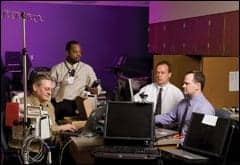
Julie Kirst, Editor
Do you have a smartphone? In a current poll on our home page, we’re asking if your employer provides a smartphone for you to use at work. At this writing, 21% said their employer does provide a smartphone for their use at work. By far the majority, at 66%, said no, but 3% said their employer hopes to, and 10% said they use their own smartphone with apps for their work. Our poll is still open, so if you haven’t taken it yet we invite you to visit our home page and take the poll.
The astronomical growth of smartphones, mobile devices, and apps, and what they can do, continues to amaze me. In many magazines, including 24×7, you can scan a QR code with your smartphone and it will take you directly to that link online. QR codes—basically two-dimensional barcodes—have a variety of uses, including tracking items and marketing products, and through increased commercial usage offer convenience to smartphone users. In our case, scanning the QR code will take you to our Buyer’s Guide online—an especially excellent tool for those working in the field.
Smartphones, in general, are cell phones that run operating systems that enable the phones to run apps—or applications. Although a more technical definition applies, Wikipedia generically defines apps as “lightweight, Web-based applications tailored to a device’s (such as a mobile phone, TV set, or tablet PC) form factor and input-output interfaces (key pad, touch pad, remote control etc).”
The social proliferation of mobile devices and the apps that expand their uses and capabilities have begun the move into health care as well. Ekahau Inc, Reston, Va, recently introduced Ekahau Mobile Survey, which it calls the first enterprise-grade Wi-Fi tool kit designed specifically to operate on mobile phones and tablets. It designed the app for smartphones and tablet computers to monitor, analyze, and troubleshoot Wi-Fi networks.
When Mark A. Carter of Ohio won an iPad from a random drawing after taking a survey sent to 24×7’s online subscribers, he said, “I look forward to using the Citrix Receiver program with the iPad to access my desktop at work.”
Now, apps have made a formal entry into health care when, on February 4, 2011, the FDA announced that it had cleared the first diagnostic radiology app for mobile devices. The new mobile radiology application—Mobile MIM from Cleveland-based MIM Software Inc—provides wireless access to allow physicians to view medical images on the iPhone and iPad.
According to the FDA, the application has the distinction as the first cleared by the FDA for viewing images and making medical diagnoses based on CT, MRI, and nuclear medicine technology, such as PET, when there is no access to a workstation.
Radiology images taken in the hospital are compressed for secure network transfer then sent to the appropriate portable wireless device via Mobile MIM software. The FDA stated that the Mobile MIM application includes labeling and safety features to mitigate the risk of poor image display due to improper screen luminance or lighting conditions.
As they say, the future is now. Will these mobile devices fall under your purview? Will they need calibration to ensure the lighting remains accurate enough to view the images? Should the mobile devices used in health care be deemed medical devices? Do you think they will provide enough accuracy to make correct diagnoses? What app would you like to see to make your job easier? Let us know what you think – blog about it with us.
Julie Kirst





